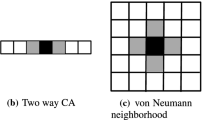Abstract
Cellular automata (CAs) are mathematical models of spatially and temporally discrete mathematical systems. Non-uniform CAs are the cellular automata in which each cell may contain a different transition rule and change it with time, while all cells share the same transition rule in regular CAs. Little is still known about the dynamics of open-ended evolution of rules in non-uniform CAs. The purpose of our study is to construct and investigate a model of non-uniform CAs capable of open-ended rule evolution exhibiting a wide variety of behavior across all Wolfram’s classes. For this purpose, we construct 1-dimensional 2-state 3 neighborhood non-uniform CAs with evolving transition rules. In the model, we found an interesting dynamics that Class II (periodical behavior) and III (chaotic behavior) patterns emerged alternately, between which Class IV patterns sometimes emerged.








Similar content being viewed by others
Explore related subjects
Discover the latest articles, news and stories from top researchers in related subjects.References
Wolfram S (2002) A new kind of science. Wolfram Media Inc, Champaign
Langton CG (1990) Computation at the edge of chaos: phase transitions and emergent computation. Phys D Nonlinear Phenom 42(1):12–37
Mori T, Kudo K, Namagawa Y, Nakamura R, Yamakawa O, Suzuki H, Uesugi T (1998) Edge of chaos in rule-changing cellular automata. Phys D Nonlinear Phenom 116(3):275–282
Packard NH (1988) Adaptation toward the edge of chaos. In: Mandell AJ, Kelso JAS, Schlesinger MF (eds) Dynamic patterns in complex systems. World Scientific, Singapore, pp 293–301
Mitchell M, Hraber PT, Crutchfield JP (1993) Revisiting the edge of chaos: evolving cellular automata to perform computations. Complex Syst 7:89–130
Sipper M (1996) Co-evolving non-uniform cellular automata to perform computations. Phys D Nonlinear Phenom 92(3):193–208
Sipper M (1997) The evolution of parallel cellular machines: toward evolware. BioSystems 42(1):29–43
Vassilev VK, Miller JF, Fogarty TC (1999) The evolution of computation in co-evolving demes of non-uniform cellular automata for global synchronisation. In: Proceedings of the 5th European Conference on Artificial Life (ECAL), pp 159–169
Romano ALT, Gomes L, Gomes G, Puma-Villanueva W, Zanetti M (2006) Evolutionary modeling of larval dispersal in blowflies using non-uniform cellular automata. In: Proceedings of the IEEE congress on evolutionary computation (CEC), pp 127–134
Romano ALT, Puma-Villanueva WJ, Zanetti MS, Von Zuben FJ (2009) Synthesis of spatio-temporal models by the evolution of non-uniform cellular automata. Found Computat Intell 4:85–104
Sondahl F, Rand W (2007) Evolution of non-uniform cellular automata using a genetic algorithm: diversity and computation. In: Proceedings of genetic and evolutionary computation conference (GECCO), p 1531
Li W, Packard N (1990) The structure of the elementary cellular automata rule space. Complex Syst 4(3):281–297
Artificial Life Laboratory at Nagoya University (2012) The poster of “Alart\_2012”. http://www.vision.ss.is.nagoya-u.ac.jp/clas/programs/docs/2012_alart2012.pdf (in Japanese)
Author information
Authors and Affiliations
Corresponding author
Additional information
This work was presented in part at the 18th International Symposium on Artificial Life and Robotics, Daejeon, Korea, January 30–February 1, 2013.
About this article
Cite this article
Sughimura, N., Suzuki, R. & Arita, T. Non-uniform Cellular Automata based on Open-ended Rule Evolution. Artif Life Robotics 19, 120–126 (2014). https://doi.org/10.1007/s10015-014-0145-1
Received:
Accepted:
Published:
Issue Date:
DOI: https://doi.org/10.1007/s10015-014-0145-1




